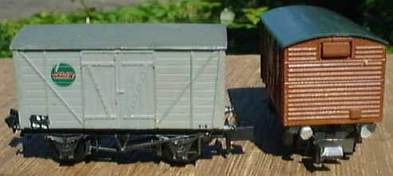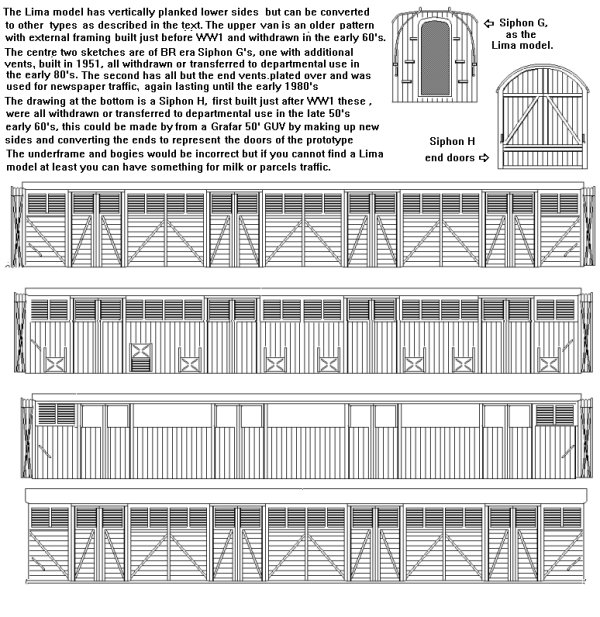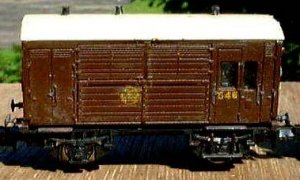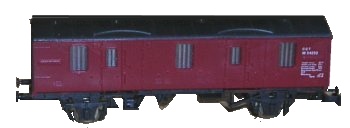Lima
(Discontinued in mid 1980's)
Cheap and providing items not found elsewhere the Lima range did suffer
from over scale height chassis and shiny wheelsets.
The 10' wb stock, and 15 foot wheelbase brake vans, fit neatly on Peco
10 or 15 foot wheelbase underframes if required. This range had some useful
bodies which can be fettled onto Peco chassis and they also produced a couple
of wagons on specialised chassis.
The axle boxes appear to be based on the LMS/BR type.
Chassis details;
The standard wagon chassis and brake van chassis represent an RCH
standard chassis with a tiebar (10 foot wheelbase, 17 foot 6 inches over
headstocks) 35.5 mm OH, 21 mm wb and 47 mm OA.
The brake van chassis is 53 mm OH, 32 mm wb and 64 mm OA.
In the specialised range there are the 12 foot wheelbase horse box
chassis.
The Prestwin hopper, an air-braked design with no hand brake; 48 mm OH,
32 mm WB and 59 mm OA.
The CCT chassis 75 mm OH, 49 mm WB and 87 mm OA.
The under frame and bogies of the Siphon G ; 103 mm OH, 115 mm OA. The
bogies are a standard GWR 'American' 7 foot wheelbase plate frame type with a
15 mm WB.
The bogies and chassis of the London Brick tippler wagon; 85 mm OH, 97
mm OA. The bogies are of a modern design as used on some BR stock and have a 12
mm WB.
_____________________________
7 PLANK OPEN - Has an end door. Fits neatly on a Peco 10' wheelbase chassis kit, either by
cutting holes in each end of the floor for the Peco coupling retainers or by using 4mm lengths of Peco sleeper as coupling plugs and gluing the body down on top. Very
useful as this was for a long time the only end-door ready-made and lettered wagon body
available. A standard RCH 1923 design and suitable for PO traders as supplied.
These wagons were also used by the railway companies and survived on BR into
the 1970's. The photos show Lima bodies on Peco chassis, the example on the right is fitted with Peco coke rails (which fit as the body is the same size as the Peco standard)
Fig___ Lima 7 plank open wagon

STEEL OPEN - BR standard 16 ton mineral wagon. Not a very good
model being too wide and high, the Hornby Minitrix ready to run and Peco 9 foot wheelbase kit models are a much
better representation of this wagon. Represents a re-bodied chassis built by
BR, these re-bodied types lacked the top doors on the sides. The picture shows the Lima model, remounted on a Peco 10 foot wheelbase chassis, alongside the Peco 16 ton mineral wagon kit.
Fig___ Lima BR 16 ton steel mineral wagon

Mounting the body on a Peco 10 foot wheelbase chassis is simple, just cut holes for the coupling retaining pins in the floor. This wagon normally runs with a 'coal load' of black 'anti-static' foam rubber so the holes are not visible.

PRESTWIN- This is a 20 ton twin-silo wagon, again hard to find
although still available in the Lima continental ranges (and also in the Arnold
range). They
were used for cement, fertiliser (running in Fisons livery, which was once
offered by Lima) and as sand carriers by British Industrial Sand. Most of the
type ended up in sand traffic by the early 1970's as the cement firms bought
more of their own stock. The Lima model (shown below left) is a Continental prototype in BR livery, the kit available to members of the 2mm Scale Association (below right, photo courtesy and copyright 2mm Scale Association) is an accurate model of the British prototype and is much more detailed. The Association also sells N Gauge wheelsets.
Fig___ Lima Prestwin silo wagon

The Lima model chassis is too long (should be 19 foot 6
inches over headstocks with a 12 foot wheelbase) but this can be cut down by
removing a section from the centre of the body and underframe to give a closer
approximation. Personally I prefer a cut down Peco 15 foot wheelbase chassis,
to get the exact length still requires some surgery on the body as the
two silo's are too far apart on the Lima model.
VENT VAN - A BR standard design introduced in about 1951, useful
for early/mid BR period layouts. The body can be re-mounted on a Peco 10'
chassis simply by cutting holes in the bottom to clear the Peco coupling
retainers. There are better models of B vans available but if you pick up some cheap Lima vans this improves them considerably. The main defect is that the end vents are used to hold the roof in position, resulting in a slightly unsightly gap, however this is barely visible in normal use.
Fig___ Lima vans on Peco chassis

A simple modification is the addition of the small vents on the
lower sides to produce a BR fruit & veg van (introduced in 1949). See also
Fig ___.
Very early BR types seem to have lacked the diagonal door strapping
although this was shown on the 'diagram' for the BR standard design. Originally
coded VEA under TOPS some of these wagons are still in use (now coded VFA).
They may remain in service for some time, with some short wheel base opens, if
only to meet the needs of Ministry of Defence depots where the curves are too
tight for the modern long wheel base stock.
This model does not resemble a GWR van, which is one of the alternative
liveries offered.
SIPHON G - GWR standard design milk churn van introduced in 1929.
Available in post 1934 GWR brown (milk or parcel traffic), as a GWR van on hire
to Palethorpes sausages (which livery is correct, although generally a simple
roof board bearing the firms name was provided), BR maroon, BR blue (both used
for parcels traffic) and BR blue `Enparts'. Enparts is the code for stock used
by BR to carry spares from one depot to another on the system, classified as
departmental stock, the last of these are believed to have been withdrawn when
Swindon works finally finished operating.

This type, with the vertical boarding
flush sides replaced an earlier type with horizontal lower boarding. Towards
the end of their service in traffic there were several modifications of this
vehicle in use, one which can be simply produced had all but the vents at the
very end of the sides outboard of the doors the louvers covered with sheet
metal (use 5 thou plasticard).
Fig ___ Siphon Variants

HORSEBOX - A GWR standard pre-grouping design (coded `Paco'),
which saw service into BR days. The one flaw is the roof vent detail; according
to the Roche drawing there should be three stubby `pots' along the centre line
of the roof (the model shown below has been modified in this way). The Lima model is supplied in the post 1934 GWR colours and in early BR
livery. These vans had `Maunsel' wheels with hardwood centres, so paint the
wheel centres a mid brown.

CCT - Standard BR design, CCT stands for Covered Carriage Truck,
and refers to the vehicle having end doors. Pre British Railways CCT's were
used to convey peoples carriages (or motor cars) and for parcels traffic. Designed to operate with the BR Mk.1 stock
this type was still in service into the early 2000s for parcels traffic.
Introduced in 1955 with the bogie GUV these were the only standard BR parcels
vehicles produced by BR. Non were ever allocated to the southern region and so
the Green livery would not have been applied to these vans. The Lima model was
available in BR maroon, BR blue and the red and white `Tartan Arrow' liveries. Tartan Arrow Services was a company set up in late 1966 which operated an overnight delivery service between London and Glasgow. They had depots at which goods were packed containers (at least some of which were in Tartan Arrow livery), these containers were then taken to the station on flat-bed trucks and craned onto railway wagons. I have not yet found information on the containers used but the ISO container was by then in use and Triang released some of their standard 30-foot containers in Tartan Arrow livery. For consignments of less than a ton in weight they also leased a number of BR parcels vans and CCT vans which were painted with their livery. The consignment could be collected by Tartan Arrow lorries or taken to the depot by the sender. The vans and container wagons were initially attached to regular BR services but from 1967 they formed 'company train' 1300 feet (400m) long with parcels vans at the front and containers at the back. At the destination the vans were passed into a company operated parcels depot and the containers were transferred to a yard equipped with a gantry crane for transfer back onto delivery lorries. I have seen mention of one the CCT vans appearing in a general parcels rake passing through Manchester Picadilly in the late 60s but the Tartan Arrow service was discontinued in about 1970 and the vans were then dispersed so they could show up anywhere on the London Midland Region in general parcels traffic. The Tartan Arrow livery had largely
disappeared by the early 1970's but odd examples may have lingered on.
I do not know when they were phased out (the only information I was able to
find was in a chronology on the
Model Rail
Express website which confirmed the start up date).
Note that due to their limited capacity (two cars) the 4-wheeled CCTs were seldom used for
motor car traffic.

CONTAINER FLAT This represents a standard Freightliner bogie flat
which entered service in 1964. The bogies on this are closer to scale than
those of the Graham Farish type. The bed of the flat is see-through, but
(unlike the Graham Farish offering) the under floor trussing is not because
this is a model of a continental container flat. This wagons serves well for
the Manchester 'Binliner' waste disposal trains which also have a solid central
girder underframe. The containers are supplied in the earliest Freightliner
standard livery; grey body with a red stripe on which appear the BR logo and
the word Freightliner.
BOGIE TANKER -A useful model for the more recent BR layouts as it
resembles some PO tanks currently serving on British tracks, although
presumably a continental prototype was used as the basis for this model. I have
no information regarding the AMOCO livery supplied, however the `MILK' livery
is fictitious (no bogie milk tanks have been used to date on BR).
CAR CARRIER - A continental design supplied with a load of
Mercedes cars. It does however resemble the British `Autic 6' six wheeled type,
developed by Standard Railway Wagon Co, introduced in 1982, and used initially
for British Leyland traffic. In the photograph one car has been removed to show the studs used to fix the cars in position. Replacing the cars with a more suitable type improves the look of the thing but the end supports for the upper deck are the wrong shape for an Autic 6 (they can be cut away and replaced with 20 thou card cut to shape).
Fig___ Lima Car Transporter

One option would be to cut away the upper deck to produce a single deck 'Comtic' lorry carrier, however you do need to add three lorries, one at each end to cover the non prototypical 'wheel arches' and one in the centre bridging the gap to hide the riveted hinge (it is best to fix the load to the hinge).
`LONDON BRICK' BOGIE TIPPLER- A continental design but it might
pass muster as an iron ore, crushed road-stone or scrap metal tippler. Similar
tippler wagons are owned by leasing companies such as Procor and are often seen
in twos or threes in Speedlink trains. The body simply un-clips from the
chassis, giving a handy 42 foot (approx.) base for a bogie flat with diamond
bogies. This is only fractionally short for a BR 30 ton bolster wagon, and the
bogies do resemble a BR type.
GW BRAKE VAN - A GWR Toad van. (Fits Peco 15' wb chassis if
required. As with the Graham Farish offering should have a 16 foot wheelbase,
but this is not noticeable in practice.)
BR BRAKE VAN- A BR standard van. (Again fits Peco 15' chassis if
required). See under Peco for further information on this item.
__________________________
^
Go to top of page









